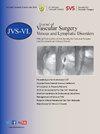Magnetic resonance imaging features of primary lower extremity lymphedema: A retrospective analysis of 228 patients
IF 2.8
2区 医学
Q2 PERIPHERAL VASCULAR DISEASE
Journal of vascular surgery. Venous and lymphatic disorders
Pub Date : 2024-11-07
DOI:10.1016/j.jvsv.2024.102004
引用次数: 0
Abstract
Background
The value of magnetic resonance imaging (MRI) presentation of primary lower extremity lymphedema in assessing the severity of lower extremity lymphedema is uncertain. The purpose of this study was to assess the role of MRI presentation in staging primary lower extremity lymphedema.
Methods
We enrolled 228 patients with clinically diagnosed primary lower limb lymphoedema from January 2018 to December 2019 in our hospital retrospectively. Patients were divided into stages I, II, and III based on the 2020 International Society of Lymphology clinical staging standards. Two radiologists assessed the following characteristics of the short-term inversion recovery sequence: the extent of edema (longitudinally and transversely); the frequency of MRI manifestations, including the presence of dermal thickening; and the morphology of edema (grid, honeycomb, parallel lines, banded, crescent, and lymphatic lake). The kappa test was used to assess interobserver agreement. The χ2 test was used to compare the frequency differences of MRI manifestations between different clinical stages. The Spearman test evaluated the correlation between edema extent and clinical stage.
Results
The extent of edema was correlated positively with clinical stage, both longitudinally and transversely. When comparing stages, the incidence of dermal thickening in stages II and III was significantly higher than in stage I. The incidence of parallel lines in stage I was significantly higher than that in stages II and III. The grid and banded sign incidence in stages I and II were significantly higher than in stage III. The incidence of honeycomb in stages II and III was significantly higher than in stage I. The incidence of lymphatic lake and crescent in stage III was significantly higher than in stages I and II (P < .001).
Conclusions
Short-term inversion recovery can sensitively diagnose lymphedema and assist in clinical staging. MRI manifestations of primary lower extremity lymphedema in different stages have specific MRI features.
原发性下肢淋巴水肿的 MRI 特征:对 228 例患者的回顾性分析。
背景:原发性下肢淋巴水肿的 MRI 表现在评估下肢淋巴水肿严重程度方面的价值尚不确定。本研究旨在评估 MRI 表现在原发性下肢淋巴水肿分期中的作用。方法:回顾性入选我院 2018 年 1 月至 2019 年 12 月临床诊断为原发性下肢淋巴水肿的 228 例患者。根据2020年国际淋巴学会(ISL)临床分期标准,将患者分为I、II、III期。两名放射科医生评估了短期反转恢复(STIR)序列的以下特征:水肿的范围(纵向和横向)、MRI表现的频率(包括真皮增厚的存在)以及水肿的形态(网格状、蜂窝状、平行线状、带状、新月状和淋巴湖状)。卡帕检验用于评估观察者之间的一致性。卡方检验用于比较不同临床分期之间 MRI 表现的频率差异。Spearman检验评估了水肿程度与临床分期之间的相关性:结果:无论是纵向还是横向,水肿程度与临床分期均呈正相关。分期比较中,Ⅱ期和Ⅲ期真皮增厚的发生率明显高于Ⅰ期,Ⅰ期平行线的发生率明显高于Ⅱ期和Ⅲ期。Ⅰ期和Ⅱ期的网格和带状征的发生率明显高于Ⅲ期。Ⅲ期淋巴湖和新月征的发生率明显高于Ⅰ期和Ⅱ期:STIR 可以敏感地诊断淋巴水肿,并有助于临床分期。不同分期的原发性下肢淋巴水肿的 MRI 表现具有特定的 MRI 特征。
本文章由计算机程序翻译,如有差异,请以英文原文为准。
求助全文
约1分钟内获得全文
求助全文
来源期刊

Journal of vascular surgery. Venous and lymphatic disorders
SURGERYPERIPHERAL VASCULAR DISEASE&n-PERIPHERAL VASCULAR DISEASE
CiteScore
6.30
自引率
18.80%
发文量
328
审稿时长
71 days
期刊介绍:
Journal of Vascular Surgery: Venous and Lymphatic Disorders is one of a series of specialist journals launched by the Journal of Vascular Surgery. It aims to be the premier international Journal of medical, endovascular and surgical management of venous and lymphatic disorders. It publishes high quality clinical, research, case reports, techniques, and practice manuscripts related to all aspects of venous and lymphatic disorders, including malformations and wound care, with an emphasis on the practicing clinician. The journal seeks to provide novel and timely information to vascular surgeons, interventionalists, phlebologists, wound care specialists, and allied health professionals who treat patients presenting with vascular and lymphatic disorders. As the official publication of The Society for Vascular Surgery and the American Venous Forum, the Journal will publish, after peer review, selected papers presented at the annual meeting of these organizations and affiliated vascular societies, as well as original articles from members and non-members.
 求助内容:
求助内容: 应助结果提醒方式:
应助结果提醒方式:


